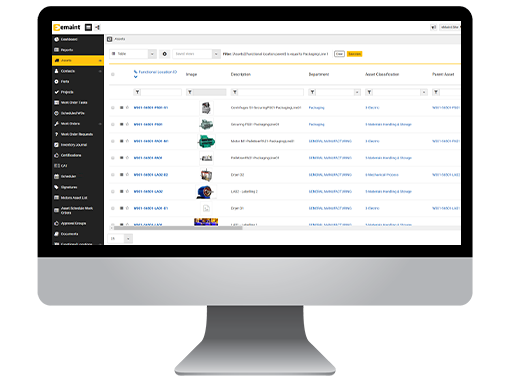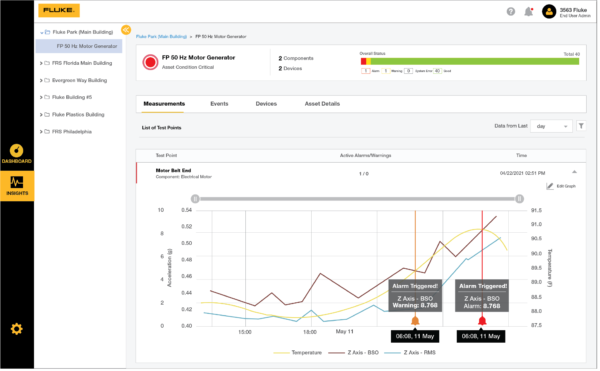What is Prescriptive Maintenance?
Prescriptive maintenance represents a cutting-edge approach to asset management, utilizing advanced analytics and machine learning to predict maintenance needs and optimize equipment performance. It goes beyond merely identifying potential issues offering specific recommendations for maintenance actions and operational adjustments. This strategy enhances the decision-making process for maintenance professionals, enabling more effective planning and execution of maintenance tasks, thereby reducing downtime and increasing asset longevity. Its intelligent application of data-driven insights positions it at the forefront of modern maintenance methodologies.

For generations, maintenance professionals have used preventive maintenance to avoid equipment failures and turned to reactive maintenance when their assets did fail. With the emergence of the Industrial Internet of Things (IIoT), maintenance professionals can now connect tools, software, and sensors to collect, store, and analyze multiple data sources in one place.
Those tools are already unlocking predictive maintenance, where sensors and software predict future failures. However, many maintenance leaders are looking toward a future based on a concept called prescriptive maintenance, where machine learning and artificial intelligence not only predict failures but also identify solutions.
How prescriptive maintenance works
Prescriptive maintenance uses machine learning (ML) and artificial intelligence (AI) together with the IIoT to make specific recommendations for equipment maintenance. It combines technologies that analyze histories, makes assumptions, test, and retest data freely. Complex algorithms enable the software to automatically identify and learn from data trends and recognize data patterns.
The machine learning process continuously reassesses models (files trained to recognize specific patterns) and data to accurately forecast what something will do at speeds unachievable by human analysts. Ultimately, prescriptive maintenance determines the potential outcomes of different actions and proposes the best approach.

How wireless vibration sensors drive prescriptive maintenance
Advanced asset condition monitoring solutions, like vibration sensors, help enable pattern detection and bring reliability teams closer to prescriptive maintenance. For example, combining a piezo vibration sensor, MEMS sensors, and software enables asset performance tracking, fault analysis, and predictive analytics.
Using vibration sensors, maintenance leaders can determine root causes and conditions impacting a machine fault, diagnose asset problems and underlying issues, and determine next steps through data analysis. Although this is still one step away from recommending a solution, which is the aim of prescriptive maintenance, it’s also one step closer to that goal.
The benefits of prescriptive maintenance
- Develop predictive maintenance models for maximizing asset life, operational performance, or uptime
- Leverage historical data and real-time data
- Optimize maintenance operations
- Minimize downtime and increase efficiency
Examples of prescriptive maintenance applications
- Automotive – Automotive plants produce some of industry’s highest-priced products due to materials and labor costs. Because prescriptive maintenance analytics can speed up overall production outputs, the time to make a product can be decreased, reducing labor and utility costs.
- Pharmaceutical – Cleanroom shutdowns can be expensive because of the need to avoid contamination. Wireless vibration sensor data and machine learning algorithms could unlock prescriptive maintenance to identify bearing wear on an air handler early and make suggestions for correcting the problem preventing an unexpected shutdown.
- Facilities – Pumps are critical to wastewater treatment plants. In a prescriptive maintenance environment, sensors could detect a change in a pump’s condition. The information gained through artificial intelligence and machine learning would help determine the best course of action, such as repairing or replacing the pump based on costs and potential outcomes.
What is predictive maintenance?
Predictive maintenance shares many similarities with prescriptive maintenance. Predictive maintenance uses data-driven, proactive maintenance methods — such as condition-based maintenance (CBM) — to analyze equipment health and help predict when maintenance should be performed.
Predictive maintenance leverages real-time data from sensors to track asset performance and historical data stored in, for instance, a Computerized Maintenance Management System (CMMS) to determine machine health. It applies algorithms to data to find trends using leading indicators, such as temperature, vibration, electrical, pressure, and other measurements that indicate when a failure is expected to happen.
Predictive maintenance vs. preventive maintenance
Predictive maintenance relies on sensors to collect data in real-time to determine machine health and identify equipment anomalies. Based on the data, maintenance teams can decide on what steps to take next.
Prescriptive maintenance does this, too, but it can also prescribe solutions and recommend the best action to take.
What is preventive maintenance?
Preventive maintenance (PM) establishes a fixed maintenance schedule for each machine, regardless of its present condition. Maintenance intervals are either calendar-based or usage-based and scheduled according to manufacturer recommendations.
Preventive maintenance reduces the incidence of reactive maintenance and unplanned downtime and increases safety by ensuring equipment is serviced regularly. There are two types of PM actions: scheduled restoration and scheduled discard. Both measures are carried out by the PM task(s) prescribed to address the precise failure mode.
In the long term, emerging technologies will enable prescriptive analytics. For example, machine learning (ML) and artificial intelligence (AI) will be able to diagnose themselves and communicate when to perform certain “restorative” or “discard” preventive maintenance tasks.

What is reactive maintenance?
Reactive maintenance is an unplanned action taken by maintenance teams when machinery fails unexpectedly, resulting in unbudgeted expenses such as overtime, downtime, and reduced production output.
Preventive maintenance vs. reactive maintenance
Preventive maintenance (PM) is planned maintenance that extends an asset’s lifetime through preventative actions such as lubrication, inspections, repairs, and replacements to avoid unplanned downtime.
Reactive maintenance is unplanned maintenance and doesn’t happen unless an asset breaks down. Once a maintenance team member identifies the root cause of the failure, a technician is sent to restore the asset to operational condition.
A run-to-failure strategy, meaning letting an asset fail, has benefits specific to an asset’s value and impact on operations which can be minimal depending on the equipment.
What is reliability-centered maintenance (RCM)?
You could say that reliability-centered maintenance, or RCM, is the granddaddy of all maintenance and reliability programs and strategies. The goal of RCM is to gather information using specific processes that enable maintenance teams to select the most appropriate asset management policy.
Using this process, reliability professionals discover and understand what must be done to ensure that all equipment continues to do what its users want it to do (functions) in its present operating context. This is achieved by identifying asset functions, functional failures, and expected failure/causes.
The final result is implementing a specific maintenance strategy for each piece of equipment at a facility or plant and optimizing the maintenance program.
The good news is you don’t need to implement all of these strategies and programs at once. There are advantages to each one and in fact, using multiple programs is generally more beneficial. Whether you start small with one strategy or a combination of maintenance programs, all of them can improve asset performance and extend equipment life.

